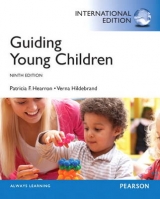
Guiding Young Children
Pearson (Verlag)
978-0-13-515164-8 (ISBN)
- Titel erscheint in neuer Auflage
- Artikel merken
The important issue of inclusion is integrated into each chapter. The coverage of managing challenging behaviors has been expanded. The authors continue to take a positive behavior approach and show how caregivers can have a positive impact on all children and their self-esteem by building a warm, supportive relationship, setting realistic expectations, and expressing confidence in the children’s ability to make good choices.
The book includes many suggestions for application assignments that will help the reader get to know individual children. The authors hope to encourage readers to think about the origins of their own values and beliefs as they encounter different ideas among colleagues and the families of children in their care.
PART I PRINCIPLES OF GUIDANCE
Chapter 1 Guiding Young Children - A Preview
Guidance: What Is It?
...And What It Is Not
Overview of What's Ahead
Why Study Guidance?
Many Factors Involved in Guidance
Goals of Guidance: Cultural and Individual Variations
Approaching Guidance Developmentally
Approaching Guidance Positively
Limits on Behavior
Whose Problem Is It?
Professional Concern for High-Quality Guidance
Evaluation
Observations
How to Use This Book
Chapter 2 Values as a Basis for Guidance
Values and Guidance
Values - Basis of Decisions
Values and the Profession
Professional Values and Accreditation
Evaluation
Ethics in the Profession
Values Into Action
Reconciling Value Differences
The Courage of Teach
Chapter 3 Knowing Children As a Basis for Guidance
Developmentally Appropriate Expectations
Understanding Typical Patterns of Development
Knowing Individual Children
Principles of Development
Speed of Development
Physical-Motor Development
Social-Emotional Development
Cognitive Development
Child Development Knowledge in Perspective
Observation
Documentation and Teacher as Researcher
Chapter 4 Collaborating with Families of Young Children
Developmentally Appropriate Practice: The Family Component
Shifting Focus from Child to Family
Cross-Cultural Competence
Laying the Groundwork: Philosophy and Goals of the Program
Initiating Relationships: Meeting Families
Building Relationships
Visiting Families in Their Homes
Readiness
The Child's First Impression of Your Program
The Role of Educators
Helping Family Members Help Their Children
Maintaining Relationships: Communicating with Families
Dealing with Setbacks
Families as Teachers
Families as Policymakers
Extending Relationships: Links with Community Resources
Preparing for What Comes Next
Detecting and Reporting Child Abuse
Your Role as a Student in the Center
Chapter 5 A Strength-Based Approach to Guidance
What are Human Resources?
Human Resource Development: The Goal
The Role of the Early Childhood Professional in Developing Human Resources
Self-Efficacy
Self-Concept
Self-Esteem
Positive Guidance
What is Positive Behavior?
Prosocial Behavior
Roadblocks to Human Resource Development
Valuing Diversity
Facilitating Acceptance
Facilitating Competence
Child Abuse
PART II STRATEGIES FOR GUIDANCE
Chapter 6 Guiding Young Children Indirectly Toward Self-Direction
Indirect Guidance
Organizing Space
Safety
Amount of Space
Personal Space
Providing Clues for Behavior
Sufficient Play Spaces
Attracting Interest
Promoting Independence
Sensory Appeal
Using Space Efficiently
Modifying Environments for Children with Disabilities
Managing Time
Scheduling
Balancing Activities
Part-Time Enrollments
Time Block Planning
Transitions
Daily Plan Sheet
Disruptions in Schedule
Recovering from Chaos
Managing Energy
Adult-Child Ratio
Group Size and Composition
Maximizing Energy Efficiency
Planning Curriculu,
Observing Children
Chapter 7 Guiding Young Children Directly Toward Self-Direction
Direct Guidance
Physical Guidance
Verbal Guidance
Planning Ahead
Affective Guidance
Punishment
PART III APPLICATIONS
Chapter 8 Guiding Young Children in Personal Care Routines
Goals for Personal Care Routines
Goals for Mealtimes
Goals for Diapering and Toileting
Goals for Rest Times
Schedules and Rhythms
Role of Culture in Personal Care Routines
The Child's Perspective
Safety and Health
Sexual Abuse
Communicating with Families
Children with Disabilities
Chapter 9 Guiding Children's Play and Learning
Goals for Learning Experiences
Developmental Perspective
Indirect Guidance
Direct Guidance
Conversations with Children
Cleaning Up
Adult-Directed Learning Experiences
Chapter 10 Guiding Young Children's Outdoor Play and Learning
Benefits of Outdoor Play
The Outdoor Play Environment
Adult Guidance
Emergencies
Field Trips
Chapter 11 Understanding and Coping with Challenging Behavior
Meaningfulness of Behavior
Establishing Appropriate Limits
Children with Disabilities
Relationships and Diversity
Observation
Helping Children Manage Their Feelings
Helping Children Manage Their Behavior
Teasing
Collaborating with Families
Teachers' Actions
Children with Disabilities
Appendix A NAEYC Code of Ethical Conduct and Statement of Commitment
Appendix B DEC Concept Paper: Identification and Intervention with Challenging Behavior
| Erscheint lt. Verlag | 17.4.2008 |
|---|---|
| Sprache | englisch |
| Maße | 232 x 189 mm |
| Gewicht | 566 g |
| Themenwelt | Sozialwissenschaften ► Pädagogik |
| ISBN-10 | 0-13-515164-3 / 0135151643 |
| ISBN-13 | 978-0-13-515164-8 / 9780135151648 |
| Zustand | Neuware |
| Informationen gemäß Produktsicherheitsverordnung (GPSR) | |
| Haben Sie eine Frage zum Produkt? |
aus dem Bereich



